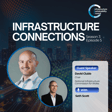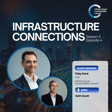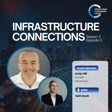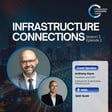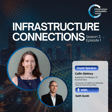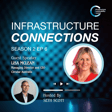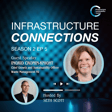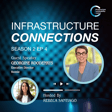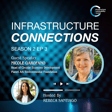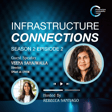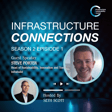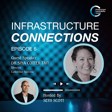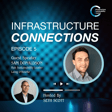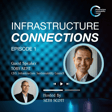Become a Creator today!Start creating today - Share your story with the world!
Start for free
00:00:00
00:00:01

How AI and physics create high-resolution climate projections
Host Seth Scott discusses with Guest Speakers Neelesh Rampal, Climate Data Scientist and Dr Peter Gibson, Climate Scientist both from NIWA on the role of data in New Zealand climate projections. We looked into their NIWA research on "High-resolution climate projects using physics and AI" and tackled its potential impacts on infrastructure.
Transcript
Introduction to Podcast
00:00:00
Speaker
The value that we have in you know all the high performance computers, you know that what we can really extract from the data we have is tremendous.
00:00:15
Speaker
Welcome to Infrastructure Connections, the podcast where we explore what makes sustainable infrastructure work, brought to you by the Infrastructure Sustainability Council. I'm your
Meet the Climate Scientists
00:00:25
Speaker
host, Seth Scott, and today we'll be speaking about how AI and physics create high-resolution climate projections with our guests, Dr. Peter Gibson and Nielish Rompol.
00:00:35
Speaker
Dr. Peter Gibson is a climate scientist at NIWA, the National Institute of Water and Atmospheric Research here in New Zealand. He focuses on regional and global climate modeling and the physical processes behind extreme weather and climate events.
00:00:48
Speaker
Nielish Rampal is a data scientist also working at NIWA. He specializes in artificial intelligence. He also holds a master's in physics from the University of Auckland. Welcome to the show.
00:01:00
Speaker
I'm
The Role of AI in Climate Science
00:01:01
Speaker
Nilesh Rampal. I work as a climate data scientist at NIWA. So I do a bit of both working on in climate science space, but I also work a lot with using kind of novel artificial intelligence approaches to to basically help our climate science.
00:01:16
Speaker
So And that's my role. What about yourself, Peter? Yes, I'm Dr. Peter Gibson. I'm a climate scientist here at NIWA. um My main focus is on physical climate modeling. So using physics-based climate models to better understand and predict you know future climate risks.
00:01:33
Speaker
um And my research is often also focused on extreme weather events, which i was obviously the most damaging to society. So trying to understand those and predict how they're changing with climate change.
00:01:45
Speaker
And stoked to be on the podcast today. Thanks for having us on here. Thanks a lot. Yeah. um I'm just curious, you know, ai physics, data, there's a lot you can do with that. You could have gone to Wall Street, I imagine.
00:01:58
Speaker
So what made you decide to go into climate change research?
00:02:04
Speaker
You go first.
Path to Climate Science: Personal Journeys
00:02:05
Speaker
Sure. Yeah, I think um for me, I think my first sort of exposure to climate science was through, um,
00:02:17
Speaker
there I think it was around 13, 14, thirteen fourteen when I first saw al Gore's Inconvenient Truth documentary. And for me, that was sort of a, I just wanted to learn a lot more about the science of climate change.
00:02:33
Speaker
um So went on a pretty big deep dive in my own time. um Obviously at high school back then, there weren't dedicated courses on climate or or anything like that. So did a lot of my own research and yeah really wanted to work in this field.
00:02:48
Speaker
um But even also when I started at university, there also weren't dedicated courses then to climate science. So i sort of did my own sort of to a combination of maths, physics, environmental science, and so that sort of came together together.
00:03:07
Speaker
in a way that when I started my post-grad, it was a nice foundation for that. But it didn't set out to necessarily be, and I want to be a climate scientist. But I think one thing I really enjoy about it is it is that, as you say, that combination of, you know, using physics, um using numbers and statistics to work on a problem of, you know, global significance that, you know, can can help hopefully help um climate resilience and and by better predictions of climate change help help save lives.
00:03:40
Speaker
That's a long journey. I'm glad you made the right choice. Yeah. For me, it was um sort of similar. I think I actually really wanted to, i think it started off being an astrophysicist. And then I think when I was and i was in my early 20s, I would often and often find myself while I was flying on a plane. I think I flew from Auckland to Bali. And for the nine hours of my whole plane journey, I just stared at the clouds and sort of took notes, which is a very nerdy thing to do.
00:04:09
Speaker
And so that's when I changed from doing sort of an astrophysics-based approach, you know, doing physics to climate. it I was like, i I feel like I can relate a whole lot more to this problem. And just seeing how fascinating, how beautiful clouds are, it was truly incredible. So I really wanted to study specifically, I wanted to go to Antarctica.
00:04:31
Speaker
So, and I found a project about Southern ocean clouds and I thought maybe if I could study Southern ocean clouds, I would find my way to Antarctica. Unfortunately, you can study clouds by satellite.
00:04:43
Speaker
So I ended up becoming a disk based person studying satellite images of clouds. Um, But it's been an absolute pleasure, you know, like the the value of satellite data, the value that we have in, you know, the high performance computers, you know, that what we can really extract from the data we have is tremendous.
00:05:02
Speaker
And so for me, you know, the amount of data we have, it's it's it's inevitable that we're going to use data science to do it. So the cool thing about my work is being able to sit at the, you know, sort of that the boundary between climate science and AI. We really need both.
00:05:18
Speaker
There's so much value in both and, you know, bringing the two disciplines together has been just absolutely exhilarating. So that's kind of what brought me to this area of work.
Challenges in Climate Projections
00:05:30
Speaker
I've always wanted to go to Antarctica too. I even applied as a chef, I think, probably just as well. They would all have got food poisoning, but yeah keep the dream alive. yeah Yeah. I'm not too sure but how useful I am there, but anyway.
00:05:45
Speaker
So um while you're working on climate change, I imagine you've come up against um big problems, obviously, but what's one of the main problems you've been trying to solve but has always maybe proven elusive or extra difficult?
00:06:00
Speaker
Yeah, I think one of the grand challenges of of climate science is oh is to make our you know climate projections more meaningful for for people on the ground.
00:06:13
Speaker
Yeah. And so the hard hard aspect of the problem, the reason why our area is hard is we're trying to basically understand, for example, how is extreme rainfall changing here in Wellington, in Sydney, in Auckland. And this is this matters for obviously infrastructure um and many other, you know, the other projects that we need to do. So for us, it's all about how can we make these physics based models help us understand what how is rainfall, how is temperature going to change?
00:06:42
Speaker
And temperature might change differently in different locations. So if you're in Auckland, the the mountains change differently to how the city changes. And we really need to capture that in our models. And that's something that we're doing in our modeling. So back us up a little bit for people who are who don't know much about climate modeling. um what How does the global model start with? How's it developed? And how's it turned into these regional models on the the grid level that you were talking about?
00:07:11
Speaker
Yeah, so it can do a bit of a climate modeling 101 if you like. So, yeah, global climate models, these are developed sort of around in the main modeling centers around the world, which, as you'd imagine, you know, are the big, sort usually government labs that have the resources to to develop and run these models.
00:07:32
Speaker
And so every five years or so, the IPCC puts out, you know, a new assessment report. And these climate models are developed on those cycles as well in a process called CMIP, coupled and model into comparison project.
00:07:48
Speaker
And the results from that feed into these IPCC reports. And so these are, yeah, as I said, global models. um Basically what it involves is taking this earth sphere and atmosphere and dividing these into grid cells.
00:08:03
Speaker
And we, at each of these grid cells, we solve equations of motion in the atmosphere, so fluid dynamics equations essentially, ah and other parts of the atmosphere and ocean and land are coupled and talk to each other and in these climate models.
00:08:23
Speaker
And i fairly these are fairly big pieces of of software. So a typical climate model might be, well, it's typically over 1 million lines of of code.
00:08:33
Speaker
um So not something that one person you know has has built themselves. these these are teams and and and really multi-generational pieces of software. um So that's part of it. And then to run them, it also requires a huge compute, not something you'd run on your laptop, for example.
00:08:52
Speaker
um Yeah, they run on big supercomputers. and And yeah, so one limit. So despite all that sophistication and and effort, a limitation of global climate models is their spatial resolution.
00:09:05
Speaker
So each grid cell in the models, when we break up the sphere of the Earth, is typically about 100 kilometres in your standard climate model today.
00:09:16
Speaker
um So, yeah, as you can imagine, you know, over Australia or New Zealand, this isn't sufficient resolution really to to answer local, you know, or regional questions about climate change, such as, you know,
00:09:28
Speaker
On this side of the mountains, you know how does climate compare to this side of the mountains? Because the mountains are influencing these things ah quite a bit. so So what we do here at NIWA and our regional modeling team, we run a regional model from the output of these global models.
00:09:47
Speaker
So the global modeling community makes all the output ah publicly available, which is an awesome resource. you know with you're talking tons and tons of data, petabytes of data, if that makes any sense. So these are that's like a lot of data that you can download. and so So we download the, we select some of the top performing global models for our region.
00:10:12
Speaker
There's sort of over 50 you can choose from. We choose the top performing ones and then we downscale with a regional model. So the regional model is Typically similar in formulation to the global models, but it's focused over a specific region. So, Neelish, let's talk about AI. i I'm assuming most people don't know much about AI. I'm talking about me here.
00:10:33
Speaker
ah Most people are familiar with ChatGPT, writing emails. ah But so obviously in simple terms, um what kind of AI are you using? i imagine you're not using ChatGPT.
00:10:44
Speaker
to come up with this information. how How does that AI get built? How do you use it? What is it? Just in ah very, very simple words. Yeah, so, I mean, ChatGPT is what we call, ah um so it's basically language. So it's a natural direct language model, basically, NLP.
00:11:02
Speaker
I sort of use convolutional neural networks. So neural networks or convolutional networks are modeled basically how our sort of brain makes decisions, neurons. And so,
00:11:14
Speaker
basically they're similar process to how our brain might make decisions. And so in the case, i give you an example, basically, for examples of these include like facial recognition. So you might, you know, you might have face ID on your phone. And so your your phone scans your face and learns that it's you, right? In the same way, we have self-driving cars.
00:11:36
Speaker
We've got cameras in the front and the The car itself is trying to make a decision on, should I turn left? Should I turn right? That's the sort of AI we're using in our research, what we call sort of visual AI in our case.
00:11:51
Speaker
so it's So it's really, i mean, you think about it, we we we as humans really easily can recognize faces and make decisions. We know that there's a tree on the road. We we turn, you know, we we stop and we we we move ah move out away from the tree.
00:12:05
Speaker
But how do you tell an AI to make that same decision. It's actually a really much more challenging problem. And the way we do it is by giving ai data. The more data we give it, the more it has the ability to learn what is the tree and what is the road.
00:12:22
Speaker
And so it will start learning things as you what is the texture of the tree and how does the texture of the tree differ from the texture of the road. And so you can kind of think of ai as learning that the tree has more contrast or more texture as opposed to what a road has. And that would hopefully inform its decision making to stop the car.
00:12:43
Speaker
um So in the same way we're detecting face, it will we will learn to recognize what's what's our specific nose pattern and so forth. So again, you can kind of think of the AI as learning things like contrast or edges of my face and learning how to make a decision based on that.
00:13:00
Speaker
so yeah How does that play into the climate modeling then? so basically the the example would be we're trying to basically predict rainfall or temperature.
00:13:11
Speaker
So we're trying so peter to introduce the global climate models, which are a very low resolution. And what we want, what people want is ultimately to have high resolution climate projections so we can resolve how extreme weather will change over cities like Wellington, Auckland, Sydney.
00:13:29
Speaker
And so this becomes a ah pretty similar problem. We're trying to predict rainfall and temperature based on what the weather or what what the um what the winds are doing basically.
00:13:41
Speaker
And so the model is now trying to learn given what the winds are doing, given what the pressure is doing, will it rain? And if so, how much? And so our predictors or what we're using, what information it's using is ah variables from the global cloud model. And we're trying to predict really high resolution rainfall.
00:14:03
Speaker
And so, um yeah, that's that's kind of an overview of how the AI works. that basically learns how to you know It learns information and patterns from these weather variables like winds.
00:14:15
Speaker
And it learns how to, from that, it learns how to decide how much rainfall will occur basically over a region. So again, are you training that based on historical models, that it's looking at those historical patterns to kind of predict the future patterns?
AI Innovations and Climate Predictions
00:14:30
Speaker
it's we we we Because we have simulations, we have the luxury. So Peter runs these simulations dynamical downscale simulations from these models, we have the luxury of having high-resolution historical simulations, but also simulations into the future.
00:14:46
Speaker
So our AI has the luxury of having 2,000 years of training data that we can train it on. So there's no shortage of data. But there is typical, you know, we also have observations that we can also train on.
00:15:00
Speaker
So we're not just limited to training on simulation. So, but in our case, what we're trying to do is we're trying to mimic what a physics based model is doing.
00:15:11
Speaker
So our our goal is purely to be faster because ai has the, you AI is, in our case, AI is really the, we're using the speed of AI.
00:15:22
Speaker
That was my next question. What is the difference between ai and physics-based computing? And I guess i've I've seen your demonstration. It looks like it's really just the speed, incredibly, ah incredible large amounts of speed compared to physics-based computing.
00:15:37
Speaker
yeah want Yeah. So the physics based models are solving equations of motion, you know, in these individual grid cells. And then we have these outputs, right? So we have the global models and you're trying to, and and then we do the dynamical downscaling and you high resolution model output.
00:15:54
Speaker
And as Nilesh was discussing before, the AI models task is to look at those inputs and outputs and get it learned that process, right? without physics, with but but through patterns, right?
00:16:06
Speaker
And so if it can do that well enough, it's it's extremely fast. And so we've spent almost three years, um you know, backtesting and looking at all the ways AI fails and then building rough robust models that that can capture this. And one, you know, little piece of...
00:16:30
Speaker
you know, tidbit of ways things fail that we've published recently is, you know, if you train your simulations just looking on the historical data only, so those historical simulations with AI models, and then you ask it, you know, tell us how rainfall will change in 30 years, it can't do that because it's only seen data from the past.
00:16:49
Speaker
If instead we train our AI models looking at future simulations and historical simulations, and then ask it to predict future, you know, future somewhere else, or from the output of a different global model, then it can start to capture these things. So just an example of of of your how things can fall over. and How much faster is AI, roughly?
00:17:12
Speaker
and it's It's tricky to put a precise number because you have to keep in mind that we only predict a handful of variables. So dynamical models can predict thousands if not tens of thousands of different variables.
00:17:25
Speaker
But the reality is that most of most most is you know most things that you know most people require only a handful of outputs. So we only predict about five outputs. And based on those five, it can be anywhere between 1,000 and 100,000 times faster.
00:17:39
Speaker
and a hundred thousand times faster Don't put a precise number on on that because there is there are some you know things that we need to, um were still we're still not quite there in terms of operationalizing it.
00:17:52
Speaker
so But the speed is just um Yeah, it could be could be anywhere between a thousand and a hundred thousand times. don't know you want to end. hundred thousand is a lot. that And this actually matters because ah computer scientists often talk about, oh, we sped up this piece of code and ah buy a hundred thousand times.
00:18:10
Speaker
Great. Okay. How long did the piece of code take to wrap? Ten seconds. Well, it doesn't actually matter that you sped it up a hundred thousand times because you saved 9.999 seconds or something. But in the case of physics-based dynamical downscaling, which I do, you know,
00:18:24
Speaker
For the latest projections we did over New Zealand, these take took one year to run on and use 70% of our supercomputer. um so So they're solving these equations for one year constantly.
00:18:36
Speaker
That's amazing. Massive of our computational results. So this is why at Neewa we have invested in an AI-based downscaling. And this is why these computational speed-ups actually do do matter And we use so we use graphics cards, the GPUs basically, as opposed to CPUs. and And with GPUs, you often might require just one GPU to run this entire AI system.
00:19:01
Speaker
Whereas with physics-based approaches, dynamical downscaling, as Peter was saying, we have to have a whole machine running. And and you could actually run this on your own laptop. No. wow So that's the advantage. We're really lowering that entry to barrier to use AI.
00:19:16
Speaker
This is obviously for for a country like you know for New Zealand, but it' it's almost obviously great, but we think about the developing world. yeah This really has the opportunity to lower that entry to barrier.
00:19:27
Speaker
We might just need to send a few, you they might not need to have that same investment of resources that, you know they don't they don't need to have their own supercomputing facility. We can just get them to potentially run these on laptops or smaller scale systems.
00:19:42
Speaker
But I have to ask the question because I know someone is going to ask this question, how much electricity does AI use and how is NILA working to address that? I would say that we're not like NVIDIA. We don't have that the same number of GPUs. In fact, we have a handful.
00:19:58
Speaker
So the reality is we're only we're not really draining that much power by training on... We've only got a handful of graphics cards. So I wouldn't see us in the same boat as these other organizations that are for our AI work. So the reality is that our power usage is much, much lower than, say, these big giants. know if you want to add anything to that. Yeah, so some of the big AI labs on the scale of 100%. hundreds of thousands of GPUs. think Facebook has something about 660,000 GPUs, whereas we have something of the order of eight.
00:20:37
Speaker
And so the trained models that they're developing are to, you know, give you preferences of what cat video to watch. Do you like this cat video over this? over this and And, you know, that requires a lot of compute because it's scaled across, you know, but Facebook's 1 billion users, right? So, um you know, you could see it that you're you're in fact saving computation. You're saving electricity because AI uses much less resources than these big physics-based models.
00:21:07
Speaker
Yeah, we're really targeting what we train. So as you as Peter was saying, there's all these cat videos. We're really only targeting several applications of AI. We're being really strategic on where we put our resources.
00:21:20
Speaker
And as we've outlined, the one at least 1,000 times saving of compute is the key benefit here. So if anything, we're using less resources, far less than what we would otherwise. So
Exploring Future Climate Scenarios
00:21:34
Speaker
I would like to think we're not in the same boat as what a lot of the other AI leader Zarin.
00:21:43
Speaker
Yeah, I think that's a, well, that's a big relief that we can continue to do modeling on climate change yeah using AI, especially if it's more powerful and we're not worried about the power draw.
00:21:53
Speaker
That's good. Could you talk a little bit about the shared socioeconomic pathway? I understand that the IPCC has several pathways and youre so you've selected one of them um as the most likely scenario. How did you reach that decision?
00:22:07
Speaker
Obviously, it's requiring projection into the future, but um when you want to make those predictions, you have to pick at least one of those paths. So what's the thought process behind that and why did you pick the one that you did?
00:22:20
Speaker
Yeah, so so the climate modeling we do at NIWA, we actually model a number of these SSPs. should so pathway So we yeah we've we've picked three to model. So one is a ah low SSP 126, is a middle middle of the road one, SSP 245, and for a sort of upper ah about upper range one, was SSP 370.
00:22:44
Speaker
So the purpose of doing this is that in the future we don't, understand well how, you know, as we've seen recently, you know, technological developments are impossible to predict, right?
00:22:58
Speaker
Population growth, perhaps a bit easier, but yeah, how how advanced technology will develop and how that impacts, you know, renewable energy and economies going forward is is is is probably beyond the realm of prediction. So we don't try and do that in climate science. Instead, what we say is,
00:23:16
Speaker
well, here's you know a range of plausible future scenarios that could happen. And these are what encompass the SSPs. um So the IPCC doesn't put a likelihood on any of these.
00:23:29
Speaker
They say you know each of these could possibly happen. um For better off or worse, that's what the IPCC does because it they not you know then it requires users to choose one. But I think it's, yeah.
00:23:41
Speaker
So choosing you know one of the upper ones is is probably sensible if you're looking at a risk-based, you know low probability, high impact future events. um But also, lower SSPs can be useful for you know if if if there's a strong mitigation pathway in the future, you know what are the benefits of differences?
00:24:02
Speaker
And in the past, um the the very, very high SSPs and ah RCPs, like SSP 585, RCP 8.5, have been criticized you know have been criticized um Especially when they've been referred to as business as usual, which, you know, in the literature, a lot of that is realistic that we would, you know have a very high emissions future just based on business as usual.
00:24:28
Speaker
So I think, you know, the climate science community has has responded to that and we tend to not, you know, they that they they aren't business as usual scenarios. But yeah, so so in this particular study, the the atmospheric study, river study, yeah we we did present results for SSP 370, which is you know, not an extremely high scenario, but yeah, and the upper bounds of of of those.
00:24:51
Speaker
Yeah, I did look at that up, the SSP3-7.0, and that's calling for a three degree warmer world, which is pretty terrifying to start with, even if that's not even the high end of the predictions, the worst case scenarios. And also that that particular one looks a lot like it's been torn from today's headlines. So I feel like that was a pretty good one to pick.
00:25:10
Speaker
It's a little bit scarily accurate about depicting what the world looks like today, especially now today as in 2025, which different than 2024 might have been.
00:25:20
Speaker
and that's the thing, right? You know, and that's a question i often get asked is, well, what pathway we are we on? And I don't think it's the right question because, as you just pointed out, you know, in a few years, you know, things change so rapidly. And and ah lot these scenarios actually tend not to diverge significantly until about 2040, 2050, when the SSP 585, the emissions really up.
00:25:48
Speaker
And the other ones like SSP, Fusy for zi the No, which we modeled in the study, are sort of more linear. And then the the the two lower ones really you know go down. so Which is not to say we have until 2040 to figure out which pathway we want, right? Certainly not, but yeah.
00:26:04
Speaker
yes yeah So, and i and I read one of your more recent papers on the results of these climate models for New Zealand. And if I'm reading it right, it said that we're expecting more extreme atmospheric rivers and 20% more annual rainfall totals in some places by the end of the century.
00:26:22
Speaker
um Specifically, I mentioned the West Coast of the South Island. um Tell us about how you approached that, how you reached those numbers and where the range was of other numbers you could have come up with.
00:26:36
Speaker
Yeah, yeah, yeah. So atmospheric rivers are one of the key research areas of our our team here. And so for New Zealand, what these are are essentially corridors of moisture transport that come out of the subtropics and tropics and pull that moisture towards New Zealand. and And when that water these big, you know,
00:26:59
Speaker
big, big volumes of water vapor when they hit mountain barriers or the likes, all that water has to go somewhere and often rains out and and particularly large atmospheric rivers in New Zealand and has caused really large historical damages.
00:27:13
Speaker
And in sort of the last three or four years, we've had a number of events that have sort of you know stacked up around the country. And so that sort of motivated our work to look at you know how will these, what's the changing nature of these events in the future?
00:27:27
Speaker
The first task was to look at our climate model output and say, do these events even happen in our climate models? Can we trust them? So we did a lot of work you know looking at historical atmospheric river events and sort of the distributions of how big they are and satellite data in the real world and comparing those into our model simulations.
00:27:47
Speaker
Do you take them all and run it backward to see if it matches existing historical events and then you feel comfortable that it can run forward and also predict? Exactly. Yeah, yeah, exactly right. So we do, to get technical for a little second, is we do a reanalysis driven run. So this is basically driving your model with observed satellite data, observed sea surface temperatures.
00:28:10
Speaker
So it's saying if it gets those observed conditions right at the in the background, can it then simulate the right conditions, you know the right rainfall amounts, the right water vapour transport pathways that that ah that we that occurred for that event.
00:28:26
Speaker
And so, yeah, we do a lot of backtesting, essentially. A lot more backtesting than we do anything else. Probably 90% to 90% of our time simulations.
00:28:38
Speaker
And testing the assumptions, right? Because because climate modelling is it much of an art as a science. So if we make you know these 10 assumptions, how does that change your results? um So, and yeah, so, oh yeah, go ahead.
00:28:53
Speaker
So, so one of the main findings from that study was yeah, exactly that, that in the future um with a warmer atmosphere, warmer atmosphere holds more water a vapor and and that tends to be more fuel for these storms.
00:29:05
Speaker
But on top of that, for particular regions, you can see changes in the jet stream, which can, you know, amplify this background, background warming and particularly in, you know, the West coast of the South Island.
00:29:17
Speaker
is one region where our model simulations are indicating this this this this could become more of an issue. and Does that mean the possibility of more cyclones as well? so So, yeah, we actually have another study which we're about to publish soon, exactly looking on this, so it changes in ex-tropical cyclones, so so tropical cyclones that come down and then affect New Zealand. But typically we treat these as distinct events, atmospheric rivers and tropical cyclones. they They can...
00:29:47
Speaker
you You know, you can get atmospheric rivers that occur with tropical so ex trocical cyclones, but you can get independent ones. so we So we sort of treat them just for process-based understanding as as sort of separate events. Specifically for infrastructure, we're looking at the assets having 50 to 100 year lifespans.
00:30:03
Speaker
what kind of um What kind of impacts does it look like climate change is promising that's going to impact that kind of infrastructure asset? One thing that might be a bit counterintuitive is in climate projections, it's actually easier.
00:30:19
Speaker
we have a better sense of the changes mid-century and end of century, so 50 to 100 years ahead, than we do over the next 10 years, because that's what we call decade of prediction, there's short term.
00:30:31
Speaker
you know, sort of five to 10 years. And that has a lot, just in the climate system, there's a lot more chaos. It's hard to know next year, will we have El Nino, next year will we have La Nina, and over the next five years, will we have, you know, more or less of these.
00:30:43
Speaker
But in the long term, you know, where it's forced, these changes are more forced by our emissions in the climate system. um that That's where these changes, you know, we we can see the the signal of them more. so So, yes, we can we can make prediction projections, you know, and and we call them projections because they're conditional on the SSPs on how much we emit. so yeah That's why I ask, because infrastructure projects are required under our rating system to take a look at the 100-year forecast. ah project predictions on the model and say in general how that's going to affect their assets. So the 100 year prediction is is perfectly valid for an infrastructure asset.
00:31:23
Speaker
Yeah. i yeah And and yeah, so so just going on. So so back to your question. So um I think. And obviously depends on the you know type of infrastructure you're working on. And we have a project now that we're hoping to spin up soon on ah sort of interconnected risk as well. So, you know, like if ah risk across regions, but also, you know, after a big cyclone or, you know, a big devastating event, you know, how does, you know, an outage here affect an outage here modelling those, you know, which which involves more than just climate science right there.
00:32:03
Speaker
Cascading failures, basically. Cascading failures and things like this. But, yeah, certainly through extreme rainfall, I think the changes in extreme rainfall, which with climate change, are quite robustly projected across our models.
00:32:15
Speaker
You know, Yeah, you know, our biggest rainmaker events, as we talked about earlier with atmospheric rivers, you know, are going to robustly increase in the amount of rain they dump. And so what might have been, you know, a 30 year, one you know, say 30 year event, you know, could be coming a one in 10 year event, one five year event.
00:32:38
Speaker
yeah I think, going to be the challenge for infrastructure design going forward to be in an in a non-stationary climate, right? What is it? So AI has been developing every year. It seems like we have a brought a breakthrough moment every year on AI.
00:32:53
Speaker
Where do you see this developing over the next five to 10 years and how is that going to help you in your research? I sort of see a synergy between AI and physics-based approaches.
Synergy of AI and Physics in Modeling
00:33:04
Speaker
I have a really strong belief that we need to have co-development. A lot of people think that AI is going to take over, at least in our in our research area, physics-based approaches.
00:33:14
Speaker
The reality is we need both. And we need to make sure we have a plan or strategy so that both grow at the same time. So for example, we need physics-based approaches to generate the training data so we can have AI approaches.
00:33:31
Speaker
So let's say we invested all our ah resources into just AI but forgot about physics. Then one day we'd realize, well, our training data is not good anymore. And so AI would suffer. So I really think there's a synergy between the the two approaches in terms of how how they grow.
00:33:47
Speaker
So I think i see generative AI really, really taking off. um Specifically in climate, we're seeing the like a lot of Armi and Peter's research, we're really seeing the benefits of generative AI.
00:34:00
Speaker
You might have seen a lot of these you know, be able generate really realistic images of cats and dogs and people. In the same way, we can use that same type of technology to now start making really realistic and physically reasonable projections of rainfall.
00:34:17
Speaker
That's exactly what our research has been about. So I really see generative AI being really, really phenomenal in this space, but I really hope that we continue to invest in both areas. it's um Yeah, just to add to that, I think it's really exciting to work in a field that is rapidly like just blowing up, essentially.
00:34:37
Speaker
Yeah, and another thing I want to talk a bit about is just briefly is uncertainty. So we talked a bit about how yeah if you're planning for infrastructure in the long term, we well what One aspect where AI is important is, obviously, we talked about how at speed we can we can do things a lot faster.
00:34:55
Speaker
And I think the reality is we one reason why we need both is we can trust physics, right? We can trust physics-based approaches. And if AI can replicate those that that those and learn those physical processes too, then we have a trustworthy system for generating climate projections and we can verify.
00:35:14
Speaker
That's why Peter's talking about hallucinations because it helps us determine whether we can trust these systems. And if we can use AI now and we trust it, we can generate what we call a ah large ensemble of climate projections. So basically we can have we can understand the uncertainty in our climate risks.
00:35:33
Speaker
So currently with physics-based approaches, they're expensive. And as a result, Peter said that we only select some climate models that we you know that are accurate, and we downscale those, we increase the resolution of those.
00:35:46
Speaker
But with ai we can have a larger number. That can tell us what is the uncertainty in those range of futures. For example, is is Auckland's rainfall going to increase by, as opposed to saying it's going to increase by, let's say, 10% or decrease by 10%, we can say there's a range of possible outcomes between 5% and 30%.
Enhancing Public Understanding of Climate Data
00:36:08
Speaker
So we can provide more of a confident, if you know confident estimate of what we think that uncertainty is. and that might help a lot in terms of decision making. So I really think AI has this huge potential to help us understand uncertainty, something we don't know much about right now. be um Just to add to that, tailris so the so the real like in 100, one in 1,000 Eurobens,
00:36:33
Speaker
is another way where I can help because by generating many, many, many more simulations, oh you can start to sample that that tail risk properly. Do you ever go back and compare it to the physics based and make sure that it's on track, say pick a random point in the future and double check?
00:36:52
Speaker
it's It's basically entirely what we spend all our time on. Training is only like a small part of it because we really, think we've talked about this, we really want to trust the AI, right? We really want to trust its decision making and until we can,
00:37:08
Speaker
um that's when we'll we'll start using it. So basically, our whole research is about, can we put AI through the most horrendous tests possible so that we we can, we actually want it to fail so we can find out how to improve it more.
00:37:21
Speaker
one of but One of the tests we do is we produce a prediction on a day with AI model, prediction on a day with our physics-based model, and we take it down the hall to our meteorologist here and say, can you tell which is which?
00:37:36
Speaker
Yeah. And yeah, we're doing a pretty good job when they... i've started We've started fooling meteorologists. yeah its doing but I think the earlier versions of AI, we weren't able to fool it. So it's basically, ah you know, we're getting better over the last couple of years.
00:37:51
Speaker
That's fantastic. you know That's good to hear. And I'm glad it's being put to good use rather than just cat videos. Yeah. So what's the one thing you think that our listeners who aren't in this field can actually do to help help you promoting the understanding and use of climate models?
00:38:10
Speaker
i mean, I think, um yeah, I think that the fact that people are interested in the output from climate models, I think this has sort of been an explosion in recent years of um certainly for us anyway, we,
00:38:25
Speaker
We talk to a lot of consultancies now and in the insurance companies, interest in the data. And so we've been working with them to understand how to use the data appropriately.
00:38:37
Speaker
What are the limitations of the data, such and such. and And these will change depending on the application, right? So it's hard to give you general... Yeah, it's about understanding their context. you know what One question that we really want to understand is how do you see uncertainty being useful for your decision-making. Well, great, Peter, Neelish. Thank you so much for being on the show. I really appreciate it Thanks so much. fine Thank you for joining us at Infrastructure Connections.
00:39:04
Speaker
Please take a moment to follow us wherever you get your podcasts and we want your feedback. Drop us a line to let us know what you think. Stay tuned for the next episode where we talk to Sam Donaldson about the task force on nature-related financial disclosure.
00:39:18
Speaker
That's coming up next on Infrastructure Connections.

